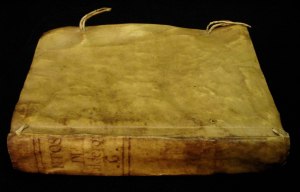Vellum

 Vellum is mammal skin obtained most commonly from calves and sheep, though it can also be produced from other animals such as goats, pigs and horses. Unlike leather, vellum is untanned, and is distinctly identifiable by its whitish color and smooth taut texture. Because of its strength and durability, vellum has been used throughout history for printing, writing and book binding. It can withstand extreme wear, but one of the drawbacks of using vellum as a book binding material is its tendency to shrink. Early binders compensated for this by adding clasps to their bindings, which held the book firmly closed and helped to prevent the covers from warping due to shrinkage. The clasps also worked to prevent vellum pages from curling. The volume shown here, in its original vellum binding, contains a series of religious moral plays written by Don Pedro Calderon (1600-1681). Calderon was one of the most important dramatists from the golden age of Spanish theater. This edition, which includes simple ball and loop clasps, was printed by Manuel Ruiz de Murga in Madrid in the year 1717.
Vellum is mammal skin obtained most commonly from calves and sheep, though it can also be produced from other animals such as goats, pigs and horses. Unlike leather, vellum is untanned, and is distinctly identifiable by its whitish color and smooth taut texture. Because of its strength and durability, vellum has been used throughout history for printing, writing and book binding. It can withstand extreme wear, but one of the drawbacks of using vellum as a book binding material is its tendency to shrink. Early binders compensated for this by adding clasps to their bindings, which held the book firmly closed and helped to prevent the covers from warping due to shrinkage. The clasps also worked to prevent vellum pages from curling. The volume shown here, in its original vellum binding, contains a series of religious moral plays written by Don Pedro Calderon (1600-1681). Calderon was one of the most important dramatists from the golden age of Spanish theater. This edition, which includes simple ball and loop clasps, was printed by Manuel Ruiz de Murga in Madrid in the year 1717.
Leave a comment